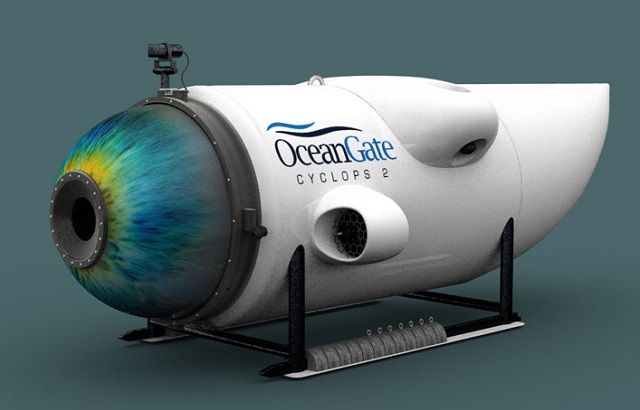Manned Submersible to Visit the Titanic in 2018
Seattle-based OceanGate Expeditions has announced that it will conduct the first manned submersible expedition to the wreck of the RMS Titanic since 2005.
The Titanic sank in April 1912 and is located 380 nautical miles from St. John’s, Newfoundland, Canada.
The vessel sank after running into an iceberg during its maiden voyage from England to New York. More than 1,500 of the ship’s 2,224 passengers and crew perished.
The price of an ticket for the OceanGate expedition is $105,129, the inflation-adjusted cost of a first-class ticket to stay in the Vanderbilt suite of the Titanic on its maiden voyage ($4,350). The 54 available positions have already been filled.
The survey expedition team will use a newly built manned submersible, Cyclops 2, to assess the condition of the shipwreck and document artifacts in the debris field. Cyclops 2 is a carbon fiber and titanium submersible capable of reaching depths of 4,000 meters (13,124 feet).
 To monitor the hull integrity of the Cyclops 2, the company relies on acoustic sensors. Sounds of a certain timbre would indicate problems with enough time to allow the researchers to abort their mission.
To monitor the hull integrity of the Cyclops 2, the company relies on acoustic sensors. Sounds of a certain timbre would indicate problems with enough time to allow the researchers to abort their mission.
The exploration team will conduct annual surveys of the wreck in collaboration with experts from the Advanced Imaging and Visualization Laboratory at the Woods Hole Oceanographic Institution as part of an on-going long-term study to document the current condition of the Titanic maritime heritage site.
The seven-week expedition will depart from St. John’s in late May 2018 with scientists, content experts and mission specialists joining the crew in a series of week-long missions. The expedition crew size for each mission will be about 20 people, including nine mission specialists, submersible pilots and operations crew.
The researchers’ subsea imaging techniques allow them to systematically document the wreck and debris field and then create a nearly lifelike digital model without disrupting any artifacts or habitat. They will also attempt to collect environmental data at the site that could be used to preserve and protect the site.
Since her sinking 105 years ago, fewer than 200 people have ever visited the wreck, far fewer than have flown to space or climbed Mount Everest, said Stockton Rush, CEO of OceanGate Expeditions.
OceanGate says the expedition will be conducted in accordance with preservation guidelines laid down by UNESCO and the National Oceanic and Atmospheric Administration. No artifacts will be collected.
“We recognize that the entire site is a memorial, and we undertake our mission with great respect for those who lost their lives in the sinking,” Rush said.
